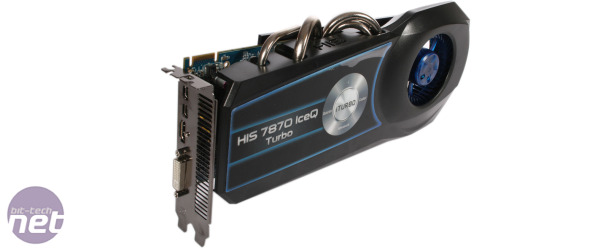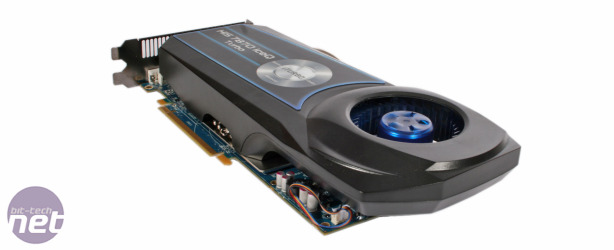
Performance Analysis
As expected, the 10 per cent GPU overclock saw the HIS 7870 IceQ perform roughly 10 per cent faster than the stock 7870 throughout our benchmarks, until memory bandwidth became more of a deciding factor at higher resolutions.In ARMA 2 at 1,920 x 1,080 with 4x AA, the 7870 IceQ's minimum frame rate of 63fps was around 2fps better than a stock HD 7870 2GB. The gap jumped to 3fps when the resolution increased to 2,560 x 1,600, scoring 37fps compared to the stock card’s 34fps. In Eyefinity at 5,760 x 1,080, the 23fps average was only one frame faster than AMD’s reference card.
In Battlefield 3 at 1,920 x 1,080 with 4x AA, the 7870 IceQ managed to beat the more expensive HD 7950 3GB with a minimum frame rate of 47fps. At 2,560 x 1,600 with 4x AA the 7950 regained its lead, with the 7870 IceQ managing a minimum of 28fps, which is still two fps faster than the stock card. The 7950 3GB extended the gap at 2,560 x 1,600, with the 7870 IceQ again bettering the reference 7870 2GB with an average of 18fps.
In Dirt 3 at single monitor resolutions, the 7870 IceQ consistently beat both the reference 7870 2GB and the more expensive 7950 3GB, with a minimum frame rate of 99fps at 1,920 x 1,080 with 4x AA and 64fps at 2,560 x 1,600 with 4x AA. At the Eyefinity resolution of 5,760 x 1,080 with 4x AA it once again fell behind the 7950 3GB, but the average frame rate of 46fps was still 3fps faster than the standard card.
At 1,920 x 1,080 with 4x AA in Skyrim, the 7870 IceQ edition outperformed both the stock 7870 2GB and the 7950 3GB with a minimum frame rate of 73fps. It was marginally slower than the 7950 3GB at 2,560 x 1,600 and performed on par with the reference card with a minimum frame rate of 53fps. This remained true at 5,760 x 1,080 with 4x AA, where the stock and overclocked cards both achieved 28fps minimum frame rates.
Performance differs from game to game, in some cases outperforming more expensive cards and in others showing very little improvement. The same is true of thermal performance and power consumption – power loads were a few watts less than the reference card, reaching just 83W when sat idling on the Windows desktop, but the 205W load power consumption was almost 20W higher than the reference card. At idle a delta T of just 8°C is higher than the 6°C managed by the reference cooler, but the load delta T of 38°C is 2°C cooler. More important however was the cooler's noise levels, which were superb. Even under heavy load, the cooler remained incredibly quiet and was inaudible over the rest of our system even after prolonged load, a rare achievement.
Overclocking
Despite coming pre-overclocked, we still thought we could squeeze a little extra performance out of the card. Using the bundled HIS iTurbo software overclocking tool, we managed to hit a stable 1,175MHz on the GPU core by increasing the core voltage to 1.3V and increased the memory frequency up to 1,375MHz (5.5GHz effective). The result was that Battlefield 3 ran at a solid minimum 30fps at 2,560 x 1,600 with 4x AA, compared to 26fps on the stock card. That’s also 1fps faster than the 7950 3GB, which costs almost £60 more.Conclusion
Following its recent price cut, the HD 7870 2GB is something of a mid-range monster right now – you can pick up a reference card for just £220. HIS has priced its HIS Radeon 7870 IceQ 2GB very competitively, meaning you only have to spend an extra £10 to get a 10 per cent factory overclockout of the box, with more in reserve thanks to the redesigned cooler. Pick one up in the next month or two and you’ll also get copies of Nexuiz and Dirt Showdown in the box. While that overclock doesn't always translate into extra performance, it can make a big difference, particularly in BF3.
Throughout our testing, the IceQ managed playable frame rates in all our games, as long as we stuck to single-screen resolutions. With only 2GB of memory and a 256-bit memory interface it struggles at higher multi-monitor resolutions where memory bandwidth becomes more of an issue, but gaming at 1080p should be no trouble – especially if you overclock it further.
Cooling performance might have been only marginally better than the reference card, but the real reason to consider the IceQ edition for your next upgrade is silence. It stayed incredibly quiet throughout our testing, only ramping up slightly when we overclocked it further than the already increased speeds HIS ship the card with. In order to achieve this, the cooler is significantly larger than the reference design, spilling over into a third PCI-E slot and taking up considerable space inside a case.
However, if you’ve got the space for it, the it’s a great value mid-range card that punches well above its weight.

-
Value27 / 30
-
Performance25 / 30


MSI MPG Velox 100R Chassis Review
October 14 2021 | 15:04










Want to comment? Please log in.